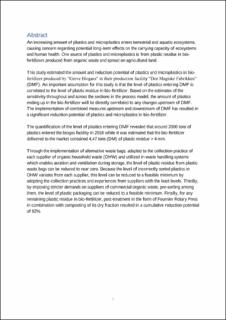| dc.contributor.advisor | Brattebø, Helge | |
| dc.contributor.advisor | Jahren, Sigrun | |
| dc.contributor.author | Fagerheim, André Beck | |
| dc.date.accessioned | 2020-06-04T16:03:40Z | |
| dc.date.available | 2020-06-04T16:03:40Z | |
| dc.date.issued | 2020 | |
| dc.identifier.uri | https://hdl.handle.net/11250/2656754 | |
| dc.description.abstract | En økende mengde plast og mikroplast gjør sin inntreden i økosystemer til lands og til vanns. Dette fører til bekymringer for potensielle langtidsvirkninger for bæreevnen til økosystemene og folks helse. En kilde til plast og mikroplast kommer fra plastrester i biogjødsel som produseres fra organisk avfall og blir sprøytet på dyrket mark.
Denne studien har estimert et reduksjonspotensiale for plast og mikroplast i biogjødsel produsert av ”Greve Biogass” i deres produksjonsfasiteter ”Den Magiske Fabrikken” (DMF).
En viktig antakelse for denne studien er at mengden plast som kommer inn til DMF er korrelert til mengden plast i biogjødsel. Basert på estimatet av sensitiviteten gjennom og på tvers av seksjonene i prosessmodellen er mengden plast i biogjødsel direkte korrelert til forandringer oppstrøms for DMF. En implementering av kombinerte tiltak oppstrøms og nedstrøms for DMF har resultert i et signifikant reduksjonspotensiale for plast og mikroplast i biogjødsel.
Kvantifisering av mengden plast har vist at rundt 2000 tonn plast ankom DMF i 2018, mens det ble estimert at biogjødsel levert til markedet inneholdt 4,47 tonn (TS) plastrester > 4 mm.
Gjennom en implementering av alternative avfallsposer, tilpasset innsamlingspraksisen for hver leverandør av matavfall og brukt i avfallssystem som tilrettelegger for lufting og ventilering under lagring, kan mengden plastrester fra plastposer bli reduser til nær null. Mengden usortert plast i matavfall varierer fra hver enkelt leverandør, men denne mengden er mulig å redusere til et minimalt nivå ved å ta i bruk innsamlingspraksisen og bruke erfaringene fra leverandørene som har minst mengde usortert plast i deres matavfall. For det tredje, ved å innføre strengere krav til leverandører av kommersielt matavfall, blandt annet førsortering av plast, kan mengden emballasjeplast bli redusert til et minimunsnivå. Som et siste tiltak kan gjenværende plastrester i biogjødselen fjernes gjennom etterbehandling i form av Fournier rotasjonspresser i kombinasjon med kompostering av tørrfraksjonen. Alle ovennenvte tiltak har blitt estimert til å ha et akkumulert reduksjonspotensiale av plastrester på 92%. | |
| dc.description.abstract | An increasing amount of plastics and microplastics enters terrestrial and aquatic ecosystems, causing concern regarding potential long-term effects on the carrying capacity of ecosystems and human health. One source of plastics and microplastics is from plastic residue in bio-fertilizers produced from organic waste and spread on agricultural land.
This study estimated the amount and reduction potential of plastics and microplastics in bio-fertilizer produced by ”Greve Biogass” in their production facility ”Den Magiske Fabrikken” (DMF). An important assumption for this study is that the level of plastics entering DMF is correlated to the level of plastic residue in bio-fertilizer. Based on the estimates of the sensitivity throughout and across the sections in the process model, the amount of plastics ending up in the bio-fertilizer will be directly correlated to any changes upstream of DMF. The implementation of combined measures upstream and downstream of DMF has resulted in a significant reduction potential of plastics and microplastics in bio-fertilizer.
The quantification of the level of plastics entering DMF revealed that around 2000 tons of plastics entered the biogas facility in 2018 while it was estimated that the bio-fertilizer delivered to the market contained 4,47 tons (DM) of plastic residue > 4 mm.
Through the implementation of alternative waste bags, adapted to the collection practice of each supplier of organic household waste (OHW) and utilized in waste handling systems which enables aeration and ventilation during storage, the level of plastic residue from plastic waste bags can be reduced to near zero. Because the level of incorrectly sorted plastics in OHW variates from each supplier, this level can be reduced to a feasible minimum by adopting the collection practices and experiences from suppliers with the least levels. Thirdly, by imposing stricter demands on suppliers of commercial organic waste, pre-sorting among them, the level of plastic packaging can be reduced to a feasible minimum. Finally, for any remaining plastic residue in bio-fertilizer, post-treatment in the form of Fournier Rotary Press in combination with composting of its dry fraction resulted in a cumulative reduction potential of 92%. | |
| dc.language | eng | |
| dc.publisher | NTNU | |
| dc.title | The Reduction Potential of Plastics and Microplastics in Bio-fertilizer | |
| dc.type | Master thesis | |
